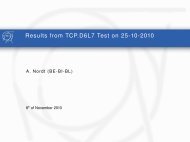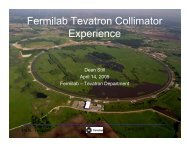Wire Scanner and downstream magnets - LHC Collimation
Wire Scanner and downstream magnets - LHC Collimation
Wire Scanner and downstream magnets - LHC Collimation
You also want an ePaper? Increase the reach of your titles
YUMPU automatically turns print PDFs into web optimized ePapers that Google loves.
<strong>Wire</strong> <strong>Scanner</strong> <strong>and</strong><br />
<strong>downstream</strong> <strong>magnets</strong><br />
Mariusz Sapinski ABBI<br />
2007/06/15 <strong>Collimation</strong>/Machine Protection WG meeting
Overview<br />
● Previous estimations<br />
● Simulated geometry<br />
● Statistics<br />
● Placement of scintillators<br />
● Cascades in magnet coils (choice of mesh)<br />
● Maximal beam intensity<br />
● Errors <strong>and</strong> approximations<br />
● errata<br />
2007/06/15 <strong>Collimation</strong>/Machine Protection WG meeting
Previous estimations<br />
● J.Bosser, C.Bovet, “<strong>Wire</strong> scanners for <strong>LHC</strong>”<br />
<strong>LHC</strong> Project Note 108 (1997): “..no<br />
superconducting dipole is expected to be<br />
located in the 40 m <strong>downstream</strong> of a wires<br />
scanner...”; limit from wire overheating is about<br />
12% of nominal beam at 7 TeV<br />
● M. Lebat, E. Petit summer students (2005 <strong>and</strong><br />
2006), who started this work<br />
2007/06/15 <strong>Collimation</strong>/Machine Protection WG meeting
<strong>Wire</strong><br />
Beam pipe<br />
3374 cm<br />
BLM<br />
Geometry<br />
MBRB<br />
4602 cm<br />
2007/06/15 <strong>Collimation</strong>/Machine Protection WG meeting<br />
MQY<br />
Coils are divided<br />
into small cells<br />
in (in r,φ,z)<br />
which energy is<br />
measured.<br />
Typically:<br />
24∙10 5 cells
Statistics<br />
● Various Monte Carlo samples were generated<br />
(Geant4.8.1)<br />
● Interaction efficiency (pwire) is about 1.32∙10 4<br />
(among 8000 protons passing the wire center 1 interacts)<br />
● Typical sample 300 – 400 events, simulation<br />
time about 20min/event (on P4 3 Ghz dual core)<br />
● lxbatch was also extensively used<br />
2007/06/15 <strong>Collimation</strong>/Machine Protection WG meeting
Placement of scintillators<br />
Particles scattered by <strong>Wire</strong> <strong>Scanner</strong> are measured by scintillators<br />
(box 10x10x1 cm) placed next to beam pipe,<br />
energy deposited in scintillators per interacting proton is:<br />
Signal in PMT scales with energy deposited in scintillators – there is a lot of<br />
signal at nominal luminosity – maximum 612 meters from WS, the signal level at<br />
6 meters does not change with energy!<br />
2007/06/15 <strong>Collimation</strong>/Machine Protection WG meeting
Particles hitting coils<br />
Spectra: low energy dominated by electrons <strong>and</strong> gamma,<br />
high by pions <strong>and</strong> protons<br />
Origin: there are almost no particles directly from the wire;<br />
impacting angle of the most energetic particles corresponds<br />
to locations on the beam screen of D4<br />
2007/06/15 <strong>Collimation</strong>/Machine Protection WG meeting
Coils: total energy depositions<br />
Q5: there are events with large<br />
energy depositions<br />
(30% of total events)<br />
2007/06/15 <strong>Collimation</strong>/Machine Protection WG meeting<br />
The average energy<br />
density is larger in Q5<br />
Q5 is a problem!
38%<br />
Q5<br />
D4<br />
Events geometry (in coils)<br />
Q5<br />
zone<br />
2007/06/15 <strong>Collimation</strong>/Machine Protection WG meeting<br />
Q5
Cascades in coils<br />
● Superconducting coil quenches if a local temperature<br />
raises above quench temperature<br />
● Local temperature depends on the local deposited<br />
energy density; for Q5 coil at 7 TeV ρ=4.95 mJ/cm 3<br />
is the assumed quench threshold<br />
(loss duration 0.3 ms, only cable entalphy used)<br />
● It is crucial to chose correctly the volumes V in which<br />
energy deposits are measured ρ=E dep /V<br />
(overestimated V ↦ underestimated ρ,<br />
underestimated V ↦ computing problems)<br />
2007/06/15 <strong>Collimation</strong>/Machine Protection WG meeting
Choice of the volume<br />
Volume size should be tuned to the shape of the shower.<br />
Average cascade measured around a hit with the highest ρ:<br />
projection of r & z projection of r & φ<br />
Sum of gaussians<br />
2007/06/15 <strong>Collimation</strong>/Machine Protection WG meeting<br />
ρ=k[wt a1 exp(bt)+(1w)l c1 exp(dl)]<br />
w”electromagneticity” of the cascade
Choice of the volume (II)<br />
Q5 cell volume has been altered (only in zdirection)<br />
Variations of maximal energy density are not critical,<br />
Slow increase of the energy density with decrease of the volumes is<br />
observed down to 0.05 cm 3<br />
St<strong>and</strong>ard range cut used<br />
in Geant4 (
Maximal energy density<br />
the method<br />
● We suffer from small statistics<br />
(how to conclude about 10 10 events having sample of 400)<br />
● Define the most “hot” region of the coil (zone)<br />
● Find probability distribution for a cell in the zone<br />
to reach a given energy density<br />
● Use the parametrized probability to estimate<br />
how many protons are needed to deposit critical<br />
energy in magnet coil<br />
2007/06/15 <strong>Collimation</strong>/Machine Protection WG meeting
The “hot” zone is:<br />
● 10 < z < 40 cm<br />
● 78 ∘ < φ < 102 ∘<br />
● ρ < 3.687 cm<br />
(variations were tested)<br />
inversed<br />
“Hot” Hot” zone<br />
2007/06/15 <strong>Collimation</strong>/Machine Protection WG meeting<br />
P(ρ)=Constant∙ρ -α ∙exp β (ρ/ρ thr )<br />
exponential cutoff at 0.87 J/cm 3<br />
10%<br />
70% 20%
Maximal beam intensity<br />
convert the probability per interacting proton into<br />
maximal beam intensity, assuming:<br />
● V wire =1m/s<br />
● Σ x =0.16 mm (3σ beam)<br />
● t scan =0.48 ms<br />
● N p<br />
<strong>LHC</strong> =3.2 ∙1014 protons<br />
● ε=1.3 ∙10 -4 interaction<br />
efficiency (cross section) 0.37.2∙10 11<br />
2007/06/15 <strong>Collimation</strong>/Machine Protection WG meeting<br />
central value 1.1
Discussion of errors<br />
● 11 Starting with value: 1.1•10 (adding errors in square)<br />
● Details of geometry seems not to be crucial, although they can change<br />
the results by about 20% (0.881.32•10 11 )<br />
● The method (used due to statistical limitations) – accuracy roughly<br />
estimated (by varying the “zone” <strong>and</strong> the fit parameters) to be around<br />
50% (0.51.7•10 11 )<br />
● Error due to size of<br />
volume 20%<br />
(0.291.91•10 11 )<br />
● Fit quality error<br />
(asymmetric):<br />
(0.287.15•10 11 )<br />
2007/06/15 <strong>Collimation</strong>/Machine Protection WG meeting
Potential gains<br />
Approximation Estimated factor Number of circulating protons Optimistic<br />
Initial 1.00E+011 7.00E+011<br />
<strong>Wire</strong> movement 0.5 2.00E+011 1.40E+012<br />
<strong>Wire</strong> shape 0.8 2.50E+011 1.75E+012<br />
Magnetic field<br />
Inside coils 0.5 5.00E+011 3.50E+012<br />
Shottky 0.5 1.00E+012 7.00E+012<br />
Nominal beam: 3.2E+14, ie.<br />
<strong>Wire</strong> <strong>Scanner</strong> should not quench the magnet up to 0.32.2% of the<br />
nominal beam (at 7 TeV plus error ie. 0.115%).<br />
(0.37)10 (0.37) 10 12 to (1.849)10 12 circulating protons<br />
2007/06/15 <strong>Collimation</strong>/Machine Protection WG meeting<br />
One bunch
Conclusions<br />
● The Q5 magnet is critical – it is more fragile <strong>and</strong> cannot be shielded –<br />
particles are hitting from the beam pipe.<br />
● <strong>Wire</strong> scanner can run up to 17∙10 12 protons in the circulating beam,<br />
ie. about 0.32% of the nominal intensity at 7 TeV<br />
2007/06/15 <strong>Collimation</strong>/Machine Protection WG meeting<br />
(ie. One bunch – safe,conservative)<br />
● What could be done: faster scanner, thinner wire (there is plenty of<br />
signal in scintillators – it can be reduced without loosing accuracy)<br />
● Additional error of the estimation of the maximal beam current is large,<br />
– accuracy of the estimation still can be increased by increasing<br />
statistics.
Errata<br />
● A small correction to results due to bunch<br />
structure of the beam should be done<br />
2007/06/15 <strong>Collimation</strong>/Machine Protection WG meeting<br />
The final result is that Q5 quench<br />
limit is reached at:<br />
2.1 +5.3<br />
1.2 ∙1011<br />
circulating protons in one beam<br />
(without taking into account<br />
potential gains)
Open questions (asked by <strong>LHC</strong> TB)<br />
1. does wire scanner affect any magnet after Q5? (Q6, 30m)<br />
2. what is the time of recovery for Q5 after one scan (without<br />
quench) – when the next scan can be performed (seconds)<br />
3. could we slow down the wire in case of scanning of one bunch,<br />
so we could have more points on beam profile<br />
4. what are the destruction limits for the wire<br />
(7 TeV <strong>and</strong> 450 GeV)<br />
2007/06/15 <strong>Collimation</strong>/Machine Protection WG meeting
Backup slides<br />
2007/06/15 <strong>Collimation</strong>/Machine Protection WG meeting
BLM locations<br />
D4 Q5<br />
2007/06/15 <strong>Collimation</strong>/Machine Protection WG meeting
Choice of the volume (II)<br />
● Particles hitting the Q5 coil:<br />
12 events<br />
Particles hitting<br />
2007/06/15 <strong>Collimation</strong>/Machine Protection WG meeting


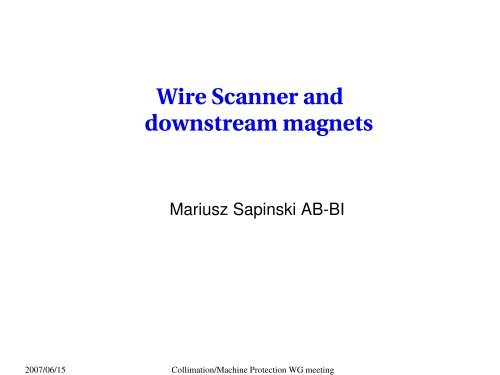
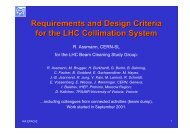
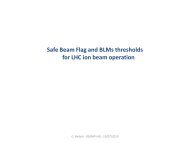
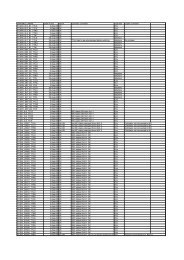
![marek.ppt [Read-Only] - LHC Collimation Working Group - Cern](https://img.yumpu.com/18209900/1/190x135/marekppt-read-only-lhc-collimation-working-group-cern.jpg?quality=85)
